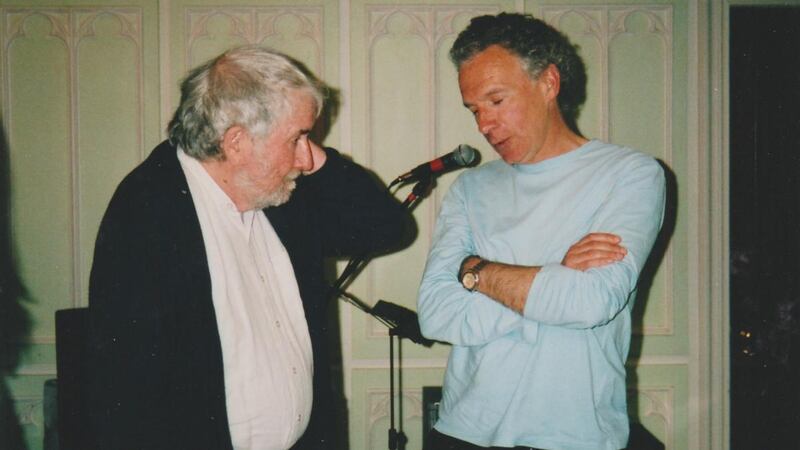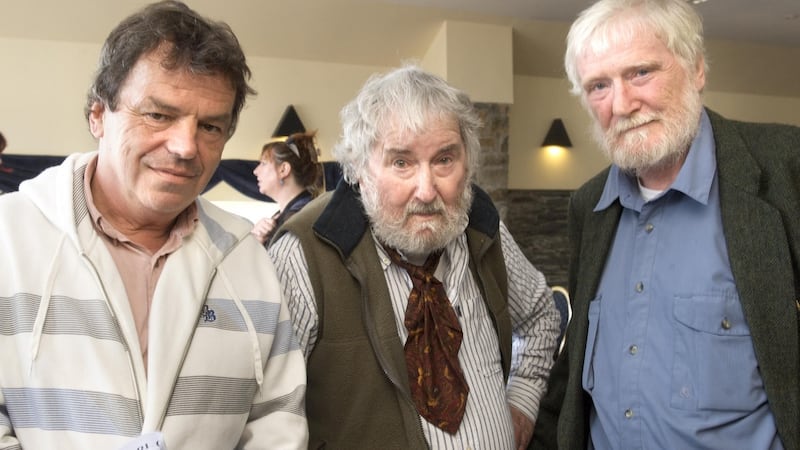Neil Donnelly said I was the hammer the film needed. Hammer, eh? The day of filming I felt more like stripped wiring, the red, blue and green raw and flailing. It was just days after Aidan Higgins’s funeral, a funeral which with fitting drama hadn’t been an actual funeral as the entrance to the crematorium was flooded, the coffin and its precious cargo returned to base, with the funeral party celebrating his life, which at the last minute I hadn’t been able to go to, going ahead in Kinsale.
I was in a rage with everyone; principally of course with myself.
The weirdness of being in his Springfield, the beautiful Georgian “Big House” in Kildare that Aidan had returned to in his writing again and again, and again. Like Van Gogh drinking black coffee until he was hallucinating before heading out to the wheatfields, Aidan dreamt himself “into a catatonic state” until he went “back there”. How strange and painful to be here with his beloved “Mumu” and Pater, his three brothers, and himself all now gone, their ghostly absence heightened by Springfield’s new mistress, an American lady who serves tea and coffee out of hellish metal thermos flasks beloved of conferences and the religious, and who has had the whole place done up in baroque rococo, and seems to keep packs of dogs, not entirely friendly, behind every second door, proclaiming loudly her intense dislike of the freshly very dearly departed: “a very nasty man”.
What?
Of course Aidan could be nasty, and being ignored almost turned him terminally nasty. He knew he was good. He knew he was very good. He knew that while he was being busily ignored here that most of those around him being carried shoulder high by the chattering classes were, by comparison, blundering toddlers in the great European world of literature he’d leaped eagerly into in his twenties, thoroughly glad to be rid of the backward-looking, self-satisfied, priest-ridden Ireland of the ’50s and ’60s. “McGahern and his old sock.”
Ow.
Naturally the more he protested, the more he poo-poohed, the more he changed agents, ditched publishers, fought with old publishers, cursed publishers new, old, and maybes, the more of an outsider he became.
He had committed the mortal sin of leaving Ireland, living abroad, marrying a blonde from South Africa, referencing Europe, European writers, using European languages in his work, sneering at the predictable. “I can’t stand the predictable. The main reason I wanted to write was to kill the predictable.”
The bare-arsed cheek of him!
It wasn’t all easy for him. Oh no.
For his 80th, long-time admirer and director Neil Donnelly mooted a festival, celebrating the life and the oeuvre. Aidan, initially disbelieving – “no one will come” – was eventually persuaded. Donnelly conjured up a fabulous cast to sing the great man’s praises: Annie Proulx of The Shipping News fame praising Aidan’s “ferocious and dazzling prose”, a style “reminiscent of intricately embroidered French 18th-century gentlemen’s vests”; our own John Banville; publisher John O’Brien of Dalkey Archive Press; Dermot Healy; an attentive-looking Fintan O'Toole. By the three days’ end Aidan was photographed with Alannah looking outrageously happy.

Some recognition at last.
Buoyed by success, Donnelly suggested a film. Again Aidan demurred. “Look,” said our about-to-be documentary filmmaker, “If you don’t like it you can always shoot me.” “Where would you like the bullet?” was Aidan’s eh, downbeat reply, a line so good it had to become the film’s title and so, 12 years after the celebrations in Kildare, four years after Aidan’s death, fittingly on his birthday, March 3rd, Where Would You Like the Bullet had its first screening in the wonderful IFI.
It’s a bit of miracle the film got made at all. There was no producer, no budget, no backers, no Arts Council funding, the entire endeavor put together by a man who’d never made a film before, helped by people working on their days off, with a smidgen of funding by, god bless ’em, Kildare County Council Arts Service.
Aidan was in with the big shooters from the get go. Samuel Beckett, later a friend, said in praise of Felo de Se, Aidan’s first collection of short stories, “in you together with the beginner we see the old hand”, the Spectator praising his “bitter, poetic intensity”, his Nabokovian writing to achieve “aesthetic bliss”, Frank O’Connor pronouncing him “in love with language, and what language can do”.
Fame arrived early for Higgins with the James Tait Black Memorial Prize for his first novel Langrishe Go Down, where he turned his “brothers into sisters”, situating them in a decaying Springfield, one sister braving a love affair with odious know-it-all lodger Otto Beck (“You are an imbecile”).
Beckett, his hero, famously disliked Langrishe, dubbing it “literary shit”. From then on the books left the relatively calm pastures of “literary novels”, heading into the rough, uncharted and less controllable waters of autobiographical fiction, a genre he perfected. A way, believes Prof Neil Murphy, “of letting the chaos in” so that “everything feels just out of our control, feels ‘fluid’.” Just like life.
The critics were not so happy.
In Balcony of Europe, his sprawling masterpiece following on from Langrishe, Aidan said he wanted to write a book in which “nothing was made up”. The story of a passionate love affair between an Irish artist (Higgins thinly disguised) and the beautiful blonde wife of an American visiting Andalucía where Jill and Higgins now lived with their three sons, Balcony was so not made up it must have been hell for Jill – to live through, and to type up. No! Yup, he had Jill type the manuscript; that she regularly threw typewriter and manuscript out the window is no surprise.
Miraculously, now in her eighties, Jill reminisces in the film with real fondness about her errant spouse, though when they went to live in Berlin on a DAAD scholarship and there was “another woman, another book” she wrote her own highly praised novel, McDaid’s Wife, about an abusive mate, her “dark and crafty husband, always only an eyelid away from trouble”, and how she felt herself “to be a shape which occupied space alone and had no feature”.
Bloody hell.
His treatment of Jill and “the lads” was the basis for the only real row we ever had: yes, you were a bastard. No, I was not.
I think he felt hideously guilty.
His much-loved friend of Berlin days, Martin Kluger, believes Aidan showed a certain “flaw of character” in “relishing the enslavement of the erotic”. Hmmm.
“There’s something missing in Irish literature if I may say so,” Aidan believed, “it’s Adam and Eve – they have been forgotten.”
Certainly the next two books after Balcony, Lions of the Grunewald and Bornholm Night Ferry, got their juice from liaisons amoureuses. Lara O Muirithe of Trinity College, a passionate devotee, believes in Lions of the Grunewald Higgins perfected the “omnisensual, omnitextual” techniques begun in Balcony. Bornholm Night Ferry, based on letters between Higgins and another, this time Danish, inamorata – the letters “titivated up” by the author – is a “masterpiece”, believes Neil Murphy; a love affair recalled with, says Prof Keith Hopper of Oxford, a “beautiful Beckettian sense of failure”.
Ironically when Jill finally kicked him out in the late Seventies the liaisons stopped; had they worked only so long as he had safe harbour, Jill and “the lads” to sail home to?

Dog Days, the second of the autobiographical trilogy, written when he was living alone in Wicklow, is described as one of his more accessible books. It’s also the driest. Apart from an astonishing portrait of his younger brother Colman, “the Dote”, and wife Stella, this was Aidan without amor, without wife, without “the lads”, barely Aidan at all.
Then he met Alannah. “I very much liked the way he listened to me,” Alannah says simply. “He took me seriously (–) this doesn’t often happen particularly with older men of distinguished literary pedigree.” And so the second marriage began. And continued, for many happy years.
More books appeared: The Whole Hog, Flotsam and Jetsam, Windy Arbour, Blind Man’s Bluff, March Hares.
Sadly, the recognition every artist craves stubbornly refused a return appearance. The early fame had cooled to near zero. The Irish reading public whom Beckett once said “couldn’t give a fart in their corduroys about art” looked resolutely the other way. Higgins was a “difficult” writer. No, he was an impossible writer! HE DID NOT REVERE JOHN MC GAHERN. WHAT WAS THE BLOODY MATTER WTH HIM?
There were academics, friends, who remained faithful – Prof Neil Murphy in Singapore, Gerry Dukes in Limerick, Keith Hopper at Oxford, the English literature department at Trinity, the University of Texas at Austin which bought his papers, writers Brian Lynch, John Banville, Adrian Kenny all cared, and still care, as well of course as the uniquely wonderful Dalkey Archive Press with imprints old and new.
Still, the pleasures, and goddamit the earthly remunerations, of fame remained elusive.
Catastrophe really struck when macular degeneration left him almost entirely blind. For a writer who thought and lived like a painter – scenes microscopically relished, dissected and described – it was a disaster. Visiting, I asked, what do you do all day? Lie on my back eating grapes and cursing my Maker was his laugh-out-loud, cry-out-loud reply.
He did manage, miraculously, to produce two more books but seeing a photo of him staring out, huge blurry glasses lashed to his face with a two-inch thick screw-on lens for the left eye, brought hot tears to mine.
Banville believes Aidan was “very unjustly forgotten in his own time”, that he was a “shy writer” – a disastrous thing to be. I think perhaps that’s a misjudgment. He wasn’t by any means a shrinking violet, and knew his stuff was good, but had modelled himself early on on the Modernists like Beckett, intensely and famously private, eschewing the hullabaloo of the market place, not even turning up to collect his Nobel, the difference being the marketplace fell all over Beckett once Waiting for Godot made it into the mainstream, whereas the mainstream lost interest in Aidan once he left traditional narrative.
Of course being a curmudgeon was part of his shtick – give the wasp’s nest a good wallop and see what flies out. Suzy O’Mullane’s portrait, with Aidan staring out angrily from a ruby red background, his beloved Nesbie on the arm of his chair, gives a glimpse of the bottled fury. Suffering fools, particularly self-satisfied fools, was not his idea of a good time at all, at all.
Meantime I needn’t have worried about looking like a hammer. I come across more like a nun. Very stern, or what my darling daughter calls “a little bit un-smiley Mum”, laying down the law according to Rosita. There shall be no prizes! There shall be no frappuccinos! (whatever the hell they are). There shall be no frivolity whatsoever!
Now that would, I think, have made him laugh.
Very well done to all.
Where Would you Like the Bullet? will be screened in the Hugh Lane Gallery on May 19th as part of the International Literary Festival Dublin











